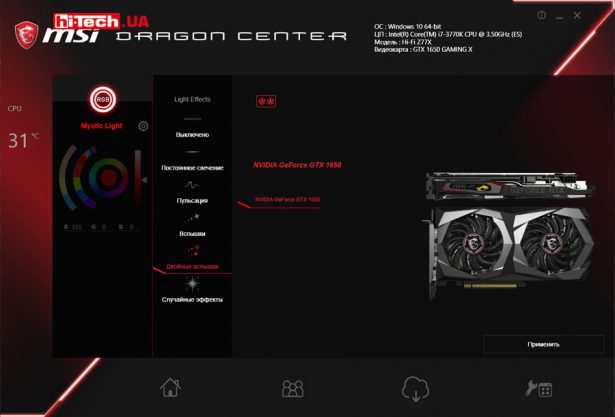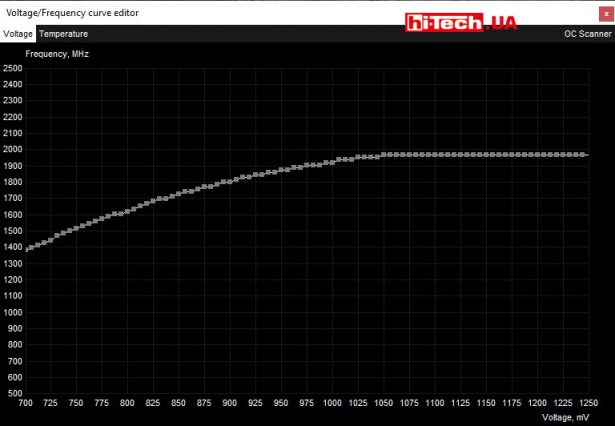MSI VENTUS and GAMING based in NVIDIA GTX 1650 tests. Appearances are deceptive
07.06.19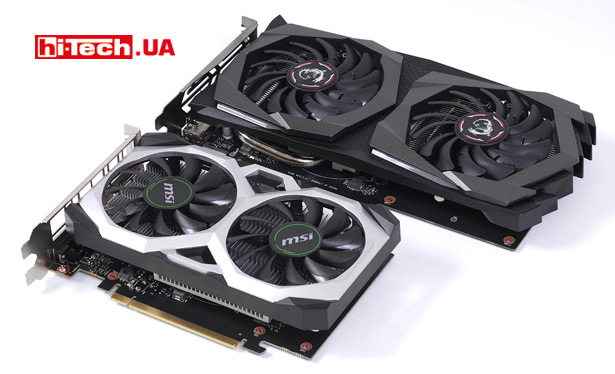
MSI GeForce GTX 1650 GAMING X 4G (top) and MSI GeForce GTX 1650 VENTUS XS 4G OC video cards
Among the new generation NVIDIA video cards based on the Turing architecture, the NVIDIA GeForce GTX 1650 is the youngest model in the hierarchy.
Video cards based on the GTX 1650 belong to the entry-level class and replace the GTX 1050, GTX 1050 Ti.
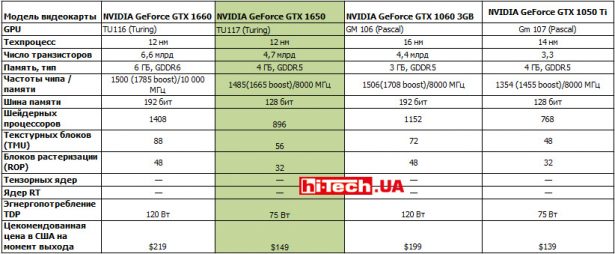
Comparison of reference characteristics of NVIDIA GeForce RTX 1660, GTX 1650, GTX 1060 3GB and GTX 1050 Ti video cards
When announcing this model, the manufacturer (NVIDIA) provided data that, compared to the previous generation GTX 1050 solution, you can expect an increase in performance in games from 30 to 70%.
Let us also recall that the prefix “GTX” and not “RTX” in the name of NVIDIA video cards based on the Turing architecture indicates the absence of new-fangled tensor cores and RT cores in the GPU.
Accordingly, video cards based on the GTX 1650, like other GTX brethren, do not have hardware support for Ray Tracing and do not support the DLSS (Deep Learning Super Sampling) anti-aliasing method.
Getting to know video cards
We tested two video cards based on NVIDIA GeForce GTX 1650 – MSI GeForce GTX 1650 GAMING X 4G and MSI GeForce GTX 1650 VENTUS XS 4G OC.
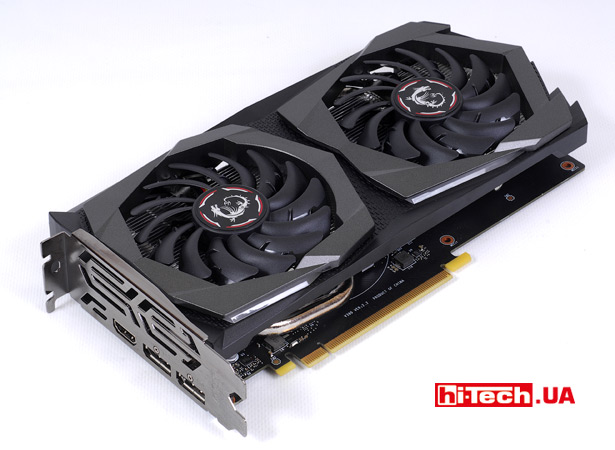

MSI GeForce GTX 1650 VENTUS XS 4G OC
They belong to different series and have significant differences in appearance.
The MSI GeForce GTX 1650 GAMING X 4G turned out to be much larger. The cooling system here uses a radiator penetrated by one heat pipe. The radiator is cooled by two 90mm fans.

Video cards MSI GeForce GTX 1650 GAMING X 4G (left) and MSI GeForce GTX 1650 VENTUS XS 4G OC
The power supply system is three-phase.
The MSI GeForce GTX 1650 VENTUS XS 4G OC has an all-aluminum radiator and does not contain heat pipes. The blower fans are smaller, their diameter is 75 mm.
Oddly enough, the power system here has the same number of phases as in the more advanced GTX 1650 GAMING X 4G. And only the GTX 1650 VENTUS XS 4G OC received an additional heatsink for the VRM elements.
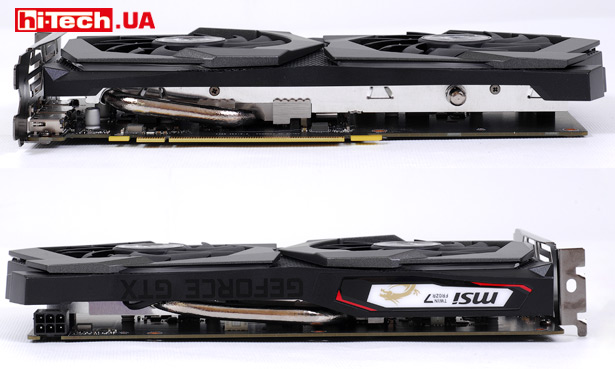
MSI GeForce GTX 1650 GAMING X 4G
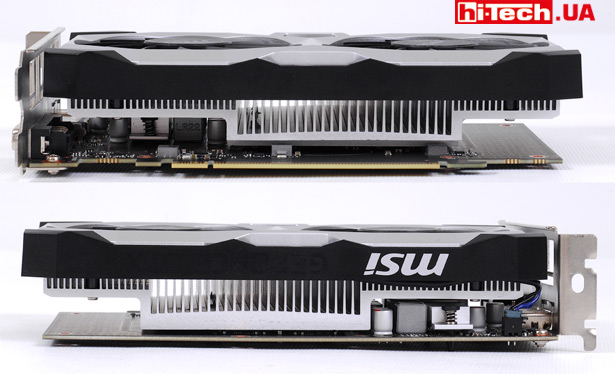
MSI GeForce GTX 1650 VENTUS XS 4G OC
If there are some differences in the set of video outputs: the GAMING X 4G series model contains two DisplayPort ports and one HDMI.
Instead of one of the DisplayPort ports, the GTX 1650 VENTUS XS 4G OC was equipped with a DVI output, and as a result, the board received one DVI, DisplayPort and HDMI output each.
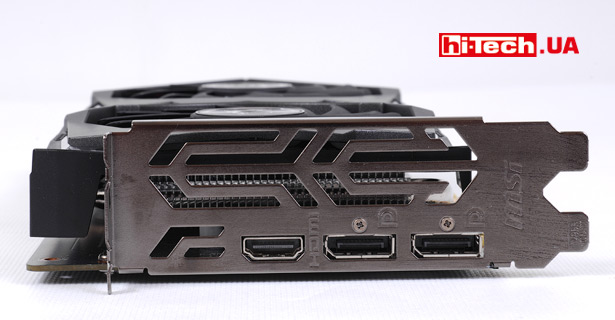
MSI GeForce GTX 1650 GAMING X 4G
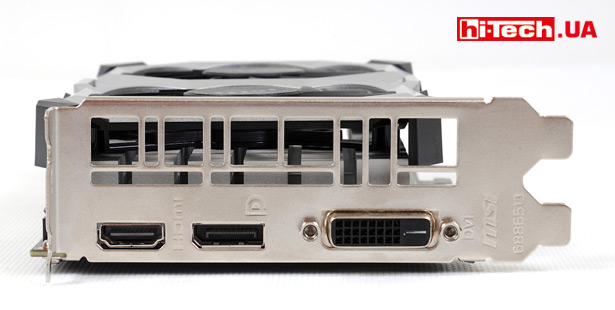
MSI GeForce GTX 1650 GAMING X 4G
For our part, we note that the relevance of the “outdated”DVI output in video cards of this class is still very high and we would call the lack of DVI in the MSI GeForce GTX 1650 GAMING X 4G a disadvantage .
The MSI GeForce GTX 1650 GAMING X 4G claims to use proprietary TORX FAN 3.0 fans.
Of the presented pair, only MSI GeForce GTX 1650 GAMING X 4G can completely stop fans at low load.
As for the frequencies, they are increased compared to the reference ones in both cases. The MSI GeForce GTX 1650 VENTUS XS 4G OC has a GPU turbo frequency of 1740 MHz, and the MSI GeForce GTX 1650 GAMING X 4G is predicted to be even higher – 1860 MHz. But the video memory of video cards is not factory overclocked and operates at the resulting standard frequency of 8000 MHz.
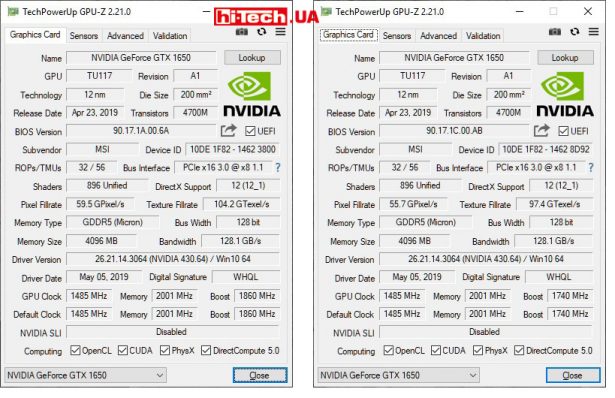
Specifications of MSI GeForce GTX 1650 GAMING X 4G (left) and MSI GeForce GTX 1650 VENTUS XS 4G OC (GPU-Z application data)
Please note that the MSI GeForce GTX 1650 VENTUS XS 4G OC, unlike the GTX 1650 GAMING X 4G, even works without additional power.
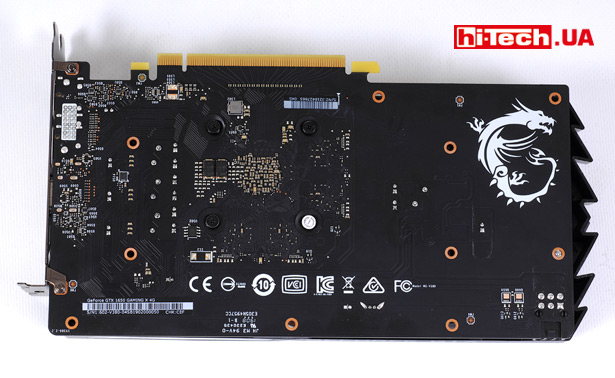
MSI GeForce GTX 1650 GAMING X 4G
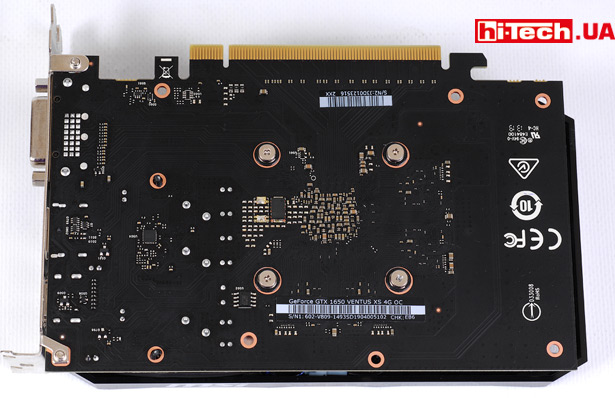
MSI GeForce GTX 1650 VENTUS XS 4G OC
The ability to increase the power limit, which is only available on the GTX 1650 GAMING X 4G, and the additional power connector provide more room for experimentation with overclocking.
Backlight, heating, noise
Of the presented video cards, only the MSI GeForce GTX 1650 GAMING X 4G has backlighting. But after installing this video card into the system and turning it on, we were faced with some disappointment.
The fact is that the backlight here is not nearly as cool as in older video cards of the new generation of theMSI GAMING series (for example, in models based on RTX 2070, GTX 1660 Ti which we tested earlier).

Backlight MSI GeForce GTX 1650 GAMING X 4G

But for comparison, the backlight of the MSI GeForce RTX 2070 GAMING Z 8G
Only the single element with the logo on the side panel lights up with a single-color glow. Some dynamic effects are available. Modestly…
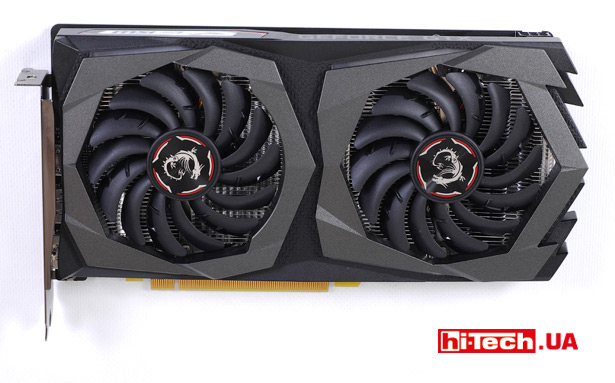
MSI GeForce GTX 1650 GAMING X 4G
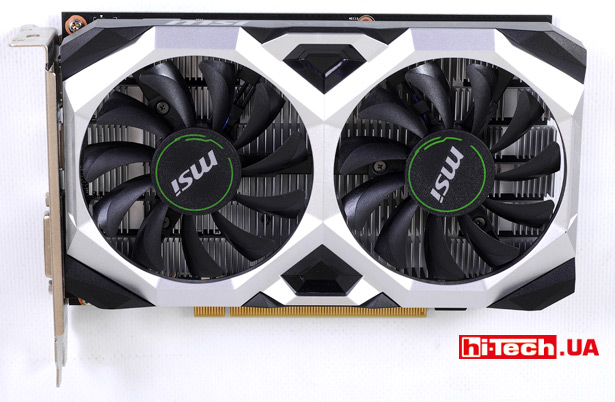
MSI GeForce GTX 1650 VENTUS XS 4G OC
Despite the more developed radiator and larger fans of the MSI GeForce GTX 1650 GAMING X 4G model, lower GPU temperatures under load were unexpectedly recorded in the MSI GeForce GTX 1650 VENTUS XS 4G OC. The maximum values were 61 and 53 °C, respectively.
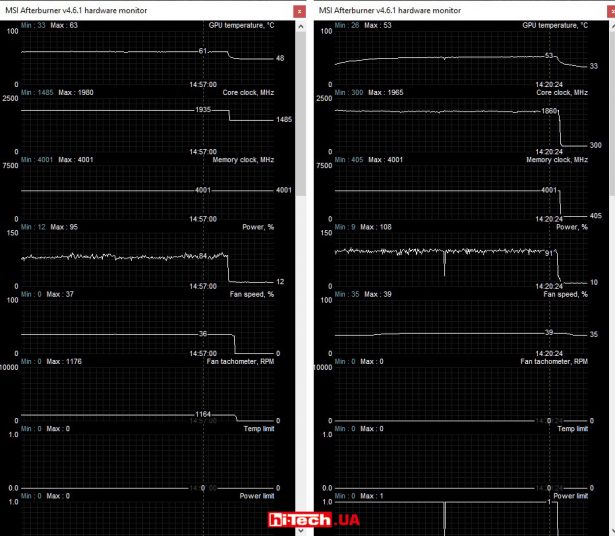
Monitoring the performance of MSI GeForce GTX 1650 GAMING X 4G (left) and MSI GeForce GTX 1650 VENTUS XS 4G in the MSI Afterburner application
With what it can be connected?
It can be assumed that the cooling system of the GTX 1650 GAMING X 4G is set to lower fan speeds. Unfortunately, the fan speed data of the MSI GeForce GTX 1650 VENTUS XS 4G OC was not displayed in either the MSI Afterburner application or GPU-Z.
In addition, when analyzing the factory curves of the dependence of GPU frequencies on voltage, we noticed that for comparable frequencies the voltage in the case of the GTX 1650 VENTUS XS 4G OC was slightly lower. This directly affects the level of heat generation.
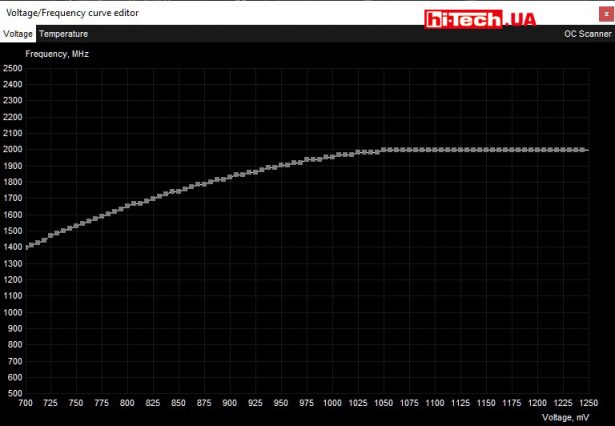
Factory curve of GPU voltage versus GPU frequency of MSI GeForce GTX 1650 VENTUS XS 4G OC video cards
In any case, both graphics cards are very quiet, and the maximum GPU temperatures shown are at very low levels.
It must be said that cooling such video cards with a declared power consumption of 75 W (GTX 1650 VENTUS XS 4G OC) and 85 W (GTX 1650 GAMING X 4G) is not a difficult task, so even a relatively modest CO is enough for effective heat removal.
Performance
To compare the performance of the presented video cards based on NVIDIA GeForce GTX 1650, we took the last generation model based on the GeForce GTX 1060 3GB, which was the MSI GEFORCE GTX 1060 ARMOR 3G OCV1, and the next-class model among video cards based on the Turing architecture, a model based on the GeForce GTX 1660, in which the MSI GeForce GTX 1660 GAMING X 6G was used.
It would also be interesting to compare the speed with the GeForce GTX 1050 Ti, but, unfortunately, we did not have such a video card.
Test platform configuration:
- Processor: Intel Core i7-3770K, overclocked to 4.4 MHz
- Motherboard: Biostar Hi-Fi Z77X
- RAM capacity: 4×4 GB DDR3 1600
- Drives: SSD Adata S511 120 GB (system), HDD 1 TB
- Operating system: Windows 10 Pro 64 bit
- Monitor: Philips 272P7VPTKEB
- Used NVIDIA driver for all video cards based on NVIDIA GeForce GTX 1060: GeForce 419.35
- Used NVIDIA driver for all video cards based on NVIDIA GeForce GTX 1660, GTX 1650: GeForce 430.64
Test results
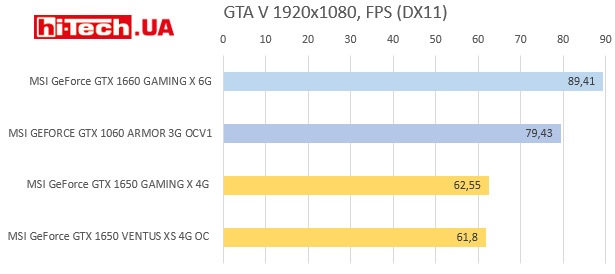
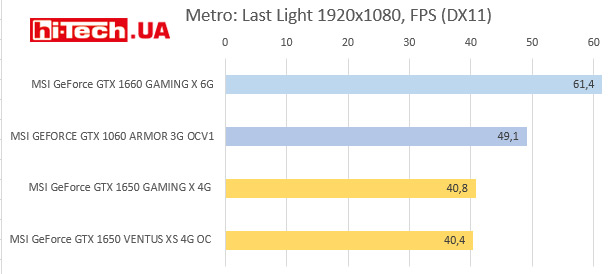
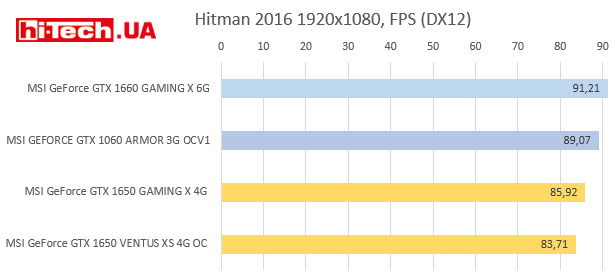
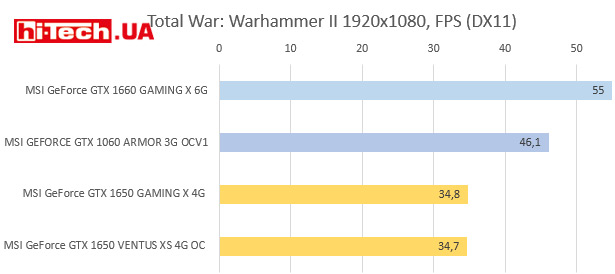
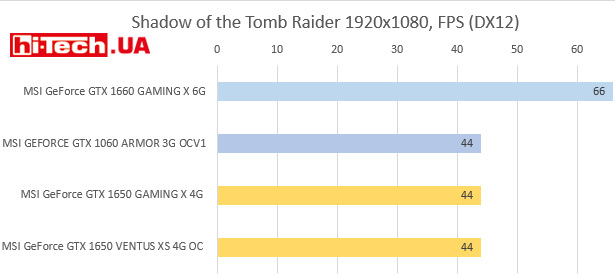
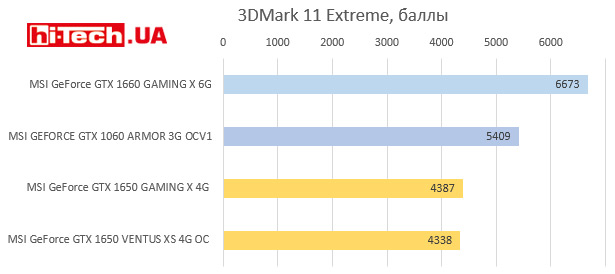
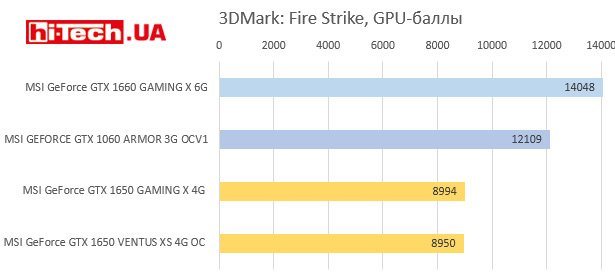
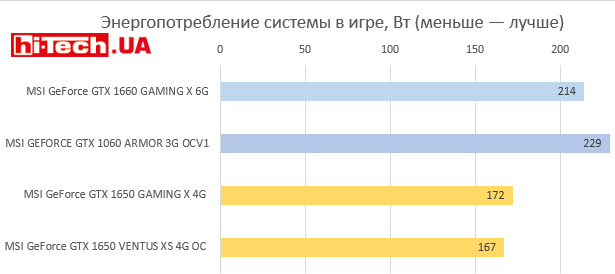
As you can see, the new entry-class GTX 1650 still failed to surpass the mid-level video card of the previous generation GTX 1060 3GB.
In some places the difference turned out to be noticeable, and in others it was quite small (mainly in newer games using DX12).
It is noteworthy that the step in performance between the neighboring new generation video cards GTX 1650 and GTX 1660 turned out to be very large. However, this is also reflected in the difference in the cost of these video cards. By choosing the GTX 1660 over the GTX 1650, you get much more speed.
Presenting the balance of power between the GTX 1050 Ti and the GTX 1060, we can conclude that the difference in performance of video cards based on the GTX 1650 compared to can reach 35%, which is quite good.
Naturally, new video cards turn out to be better than their predecessors in terms of performance/power consumption ratio.
As for the pair MSI GeForce GTX 1650 GAMING X 4G and MSI GeForce GTX 1650 VENTUS XS 4G OC, there is a difference between them in favor of the GAMING X 4G, but small. And it is due to slightly higher operating frequencies.
Conclusions
Considering how different the MSI GeForce GTX 1650 GAMING X 4G and the MSI GeForce GTX 1650 VENTUS XS 4G OC turned out to be, one could assume that the GAMING X 4G would be much more advanced.
In fact, it turned out that there are not so many differences between them.
The GTX 1650 GAMING X 4G is only slightly superior to the GTX 1650 VENTUS XS 4G OC in performance; its fans, unlike the VENTUS XS 4G OC, can stop completely at low loads, and only it received backlighting, which, by the way, is quite modest.
Potentially, the GTX 1650 GAMING X 4G has slightly better overclocking.
At the same time, both video cards deserve praise: they operate quietly and provide a very comfortable temperature level for the GPU.
On the side of the GTX 1650 VENTUS XS 4G OC is compactness, if this is important to you, and no need to connect additional power.
Both the MSI GeForce GTX 1650 GAMING X 4G and the MSI GeForce GTX 1650 VENTUS XS 4G OC are very worthy representatives of video cards based on NVIDIA GeForce GTX 1650.
If these few advantages of the GTX 1650 GAMING X 4G are important to you, then you can pay a little extra for it. By the way, the price difference between the presented video cards is small.
Characteristics MSI GeForce GTX 1650GAMINGX 4G
| Model | NVIDIA GeForce GTX 1650 |
| Interface | PCI Express 3.0 x16 |
| GPU | TU117 |
| Technical process | 12 nm |
| Video memory | 4 GB, GDDR5 |
| Memory bus | 128 bit |
| GPU frequency | 1860 (boost) MHz |
| Resulting memory frequency | 8000 MHz |
| Supports DirectX instructions | 12 |
| Outputs | HDMI, 2xDisplayPort |
| Additional power connector | 6 Pin |
| Energy consumption | 85 W |
| Supplier | MSI Representative |
| Price | $209 |
Rating:
+ excellent cooling system
+ fans switch off at low load
+ significantly increased GPU frequencies
+ low power consumption
- a DVI output would be nice
- the backlight is very modest
Characteristics MSI GeForce GTX 1650VENTUSXS 4GOC
| Model | NVIDIA GeForce GTX 1650 |
| Interface | PCI Express 3.0 x16 |
| GPU | TU117 |
| Technical process | 12 nm |
| Video memory | 4 GB, GDDR5 |
| Memory bus | 128 bit |
| GPU frequency | 1740 (boost) MHz |
| Resulting memory frequency | 8000 MHz |
| Supports DirectX instructions | 12 |
| Outputs | HDMI, DisplayPort, DVI |
| Additional power connector | – |
| Energy consumption | 75 W |
| Supplier | MSI Representative |
| Price | $195 |
Rating:
+ excellent cooling system
+ increased GPU frequencies
+ low power consumption
+ compact dimensions
+ does not require additional power
- no backlight
- there is no fan stop mode
See also:
- Comparative test of NVIDIA GTX 1660 Ti video cards from ASUS, MSI, Gigabyte and Inno3D. Did you remove the excess?
- Review and comparison of video cards based on NVIDIA RTX 2070 from ASUS, Gigabyte, Inno3D and MSI
Engineer of the Test Laboratory
Don't miss interesting news
Subscribe to our channels and read announcements of high-tech news, tes
Oppo A6 Pro smartphone review: ambitious

Creating new mid-range smartphones is no easy task. Manufacturers have to balance performance, camera capabilities, displays, and the overall cost impact of each component. How the new Oppo A6 Pro balances these factors is discussed in our review.
Editor’s Choice 2025. Best devices of the year by hi-tech.ua

The best gaming laptops, mice for work, gaming keyboards, smartphones, and wireless headphones of 2025. Among them, we will highlight the most interesting ones and those that we can recommend buying.
ASUS ROG release gaming monitor with 5K 180Hz and QHD 330Hz matrix Asus monitor
Asus ROG on the eve of CES 2026 introduced the ROG Strix XG27JCG gaming monitor, which received a dual operating mode and, according to the company, became the first in its class
iRobot has declared bankruptcy business
The American company iRobot, which once made robotic vacuum cleaners a mass product thanks to the Roomba line, has officially declared bankruptcy.

